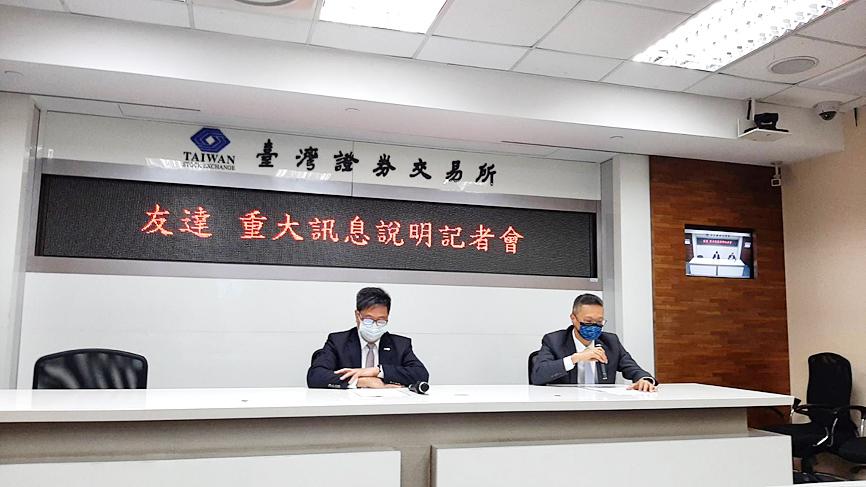LCD panel maker AU Optronics Corp (AUO, 友達光電) yesterday introduced its first share capital reduction program and a NT$55.77 billion (US$1.94 billion) return distribution program in a three-year span starting this year.
The program’s aim is to improve shareholders’ long-term return on equity, the company said.
AUO shareholders this year are to receive a cash dividend of NT$3 per share, including NT$1 from last year’s earnings and NT$2 paid back by the company through a 20-percent share capital reduction plan.

Photo: Chen Mei-ying, Taipei Times
The company expects share capital to fall to NT$76.99 billion after the program takes effect in June.
As a result, AUO’s payout ratio would reach 46.5 percent based on the company’s earnings per share last year of NT$6.44. The distribution would cost the company NT$28.82 billion this year, it said.
The distribution program reflects AUO’s long-term efforts to improve its financial structure and to transform itself into a supplier of valued-added flat panels, the company said.
The value-added products, which include premium panels and other products used in vehicles, medical devices and industrial equipment, are less exposed to industry fluctuations, and contributed about 50 percent to the company’s revenue last quarter, it said.
“AUO has confidence that it can reduce the influence of industry cycles and generate a balanced operating cash flow. We commit to delivering stable and clear three-year shareholder returns to enhance long-term shareholder equity and corporate values,” AUO chairman Paul Peng (彭雙浪) told a media briefing in Taipei yesterday.
“To cope with the rapidly growing LCD panel industry, the company has broadened operational scale through share capital expansion. We now believe the company is capable of generating better profits with streamlined share capital,” he said.
AUO does not expect the outlays to affect operations and investments in new manufacturing facilities, given its ability to generate healthy cash flow, Peng said, adding that the company last year generated about NT$104.7 billion in cash from operations, helping to reduce AUO’s net debt-to-equity ratio to minus-10.6 percent at the end of last year.
The company has accumulated NT$80.67 billion in retained earnings and NT$60.06 billion in capital surplus, he said.
AUO last month announced an investment in a G8.5 production line in Taichung, its first new line since 2010. It is to begin operation in 2025.
An investment of NT$100 billion to NT$150 billion is likely needed to reach full capacity, Peng said.
To fund new capacity expansion in Kunshan, China, AUO raised its capital expenditure to NT$45 billion this year from NT$17 billion last year, he said.

Nvidia Corp’s demand for advanced packaging from Taiwan Semiconductor Manufacturing Co (TSMC, 台積電) remains strong though the kind of technology it needs is changing, Nvidia CEO Jensen Huang (黃仁勳) said yesterday, after he was asked whether the company was cutting orders. Nvidia’s most advanced artificial intelligence (AI) chip, Blackwell, consists of multiple chips glued together using a complex chip-on-wafer-on-substrate (CoWoS) advanced packaging technology offered by TSMC, Nvidia’s main contract chipmaker. “As we move into Blackwell, we will use largely CoWoS-L. Of course, we’re still manufacturing Hopper, and Hopper will use CowoS-S. We will also transition the CoWoS-S capacity to CoWos-L,” Huang said

Nvidia Corp CEO Jensen Huang (黃仁勳) is expected to miss the inauguration of US president-elect Donald Trump on Monday, bucking a trend among high-profile US technology leaders. Huang is visiting East Asia this week, as he typically does around the time of the Lunar New Year, a person familiar with the situation said. He has never previously attended a US presidential inauguration, said the person, who asked not to be identified, because the plans have not been announced. That makes Nvidia an exception among the most valuable technology companies, most of which are sending cofounders or CEOs to the event. That includes

INDUSTRY LEADER: TSMC aims to continue outperforming the industry’s growth and makes 2025 another strong growth year, chairman and CEO C.C. Wei says Taiwan Semiconductor Manufacturing Co (TSMC, 台積電), a major chip supplier to Nvidia Corp and Apple Inc, yesterday said it aims to grow revenue by about 25 percent this year, driven by robust demand for artificial intelligence (AI) chips. That means TSMC would continue to outpace the foundry industry’s 10 percent annual growth this year based on the chipmaker’s estimate. The chipmaker expects revenue from AI-related chips to double this year, extending a three-fold increase last year. The growth would quicken over the next five years at a compound annual growth rate of 45 percent, fueled by strong demand for the high-performance computing

TARIFF TRADE-OFF: Machinery exports to China dropped after Beijing ended its tariff reductions in June, while potential new tariffs fueled ‘front-loaded’ orders to the US The nation’s machinery exports to the US amounted to US$7.19 billion last year, surpassing the US$6.86 billion to China to become the largest export destination for the local machinery industry, the Taiwan Association of Machinery Industry (TAMI, 台灣機械公會) said in a report on Jan. 10. It came as some manufacturers brought forward or “front-loaded” US-bound shipments as required by customers ahead of potential tariffs imposed by the new US administration, the association said. During his campaign, US president-elect Donald Trump threatened tariffs of as high as 60 percent on Chinese goods and 10 percent to 20 percent on imports from other countries.